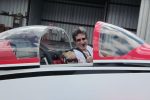We almost got to ride in a 1928 Ford Tri-Motor.
We bought her a red Avcomm headset when she was three. She’s flown in a Cessna 210 and an RV-6 which she calls “Papa’s red plane.”
 Over Christmas vacation, she was playing in the park when she spotted a yellow Piper Cub flying overhead. She told me that it was a seaplane and that it belonged to Mr. Brown. She knew this because Jack Brown’s Seaplane Base uses nearby lakes to practice landings, like the lake near her house in Auburndale.
Over Christmas vacation, she was playing in the park when she spotted a yellow Piper Cub flying overhead. She told me that it was a seaplane and that it belonged to Mr. Brown. She knew this because Jack Brown’s Seaplane Base uses nearby lakes to practice landings, like the lake near her house in Auburndale.
Next to McDonald’s, her favorite place to eat is at the restaurant at Winter Haven’s Gilbert Field. She enjoys watching planes and helicopters land and take off.
She asked if she would need to bring her headset. Huh. I hadn’t thought to ask when I bought the tickets, so I called the number on the flyer 877-952-5395 to ask.
EAA’s Tim Hoversten explained that there would be no place to plug in a headset in the passenger area. “There are two Ford Tri-motors we operate. One we own is a 4-AT that’s in maintenance right now and then it’s going to Texas. The 5-AT-B Liberty Ford in Florida is leased from Liberty Aviation Museum in Port Clinton, Ohio. It was built in 1928.”
On a bright, clear Thursday, we arrived at the Lakeland Aero Club hangar and found people milling about, all waiting, like us for the plane to return from the first flight of the day. This particular Ford Tri-Motor (NC9645), serial number 8, was used in commercial flights by TWA and for sightseeing trips over the Grand Canyon and the Boulder Dam.
Giana took photos with my cell phone. When it taxied up to the hangar, she counted the propellers and gave me a quizzical look. I explained that tri means three.
As the Pratt & Whitney R-985 series engines shut down, I spotted Director of the Lakeland Aero Club, Mike Zidziunas, riding shotgun. After he disembarked, he pointed to the aircraft. “That’s the Concorde of its day. It flew twice as fast as any other form of transportation available.”
A speed of 78 knots in cruise doesn’t impress people today but compared to the cars and trains of the 1920s, that speed must have been a big deal.
Pilot Cody Welch was the last person off the plane. He told the volunteers from the Lakeland Aero Club that he wouldn’t be able to take any more flights for the day because the starter had to be replaced. “Routine maintenance,” he said, “but it couldn’t be put off.”
Giana was disappointed we couldn’t fly, but she decided to take selfies in and outside the aircraft. She then asked for copies of my photos to show her teacher. Due to our schedules, we were unable to return for another time to fly that weekend. According to the EAA website, the Ford Tri-Motor was also “the first airplane put into commercial service by the United States.” Pan American Airways used Ford Tri-Motors to fly from Key West, Florida to Havana, Cuba in the late 1920s. The Ford Tri-Motor was the first plane over the south pole, too!
According to the EAA website, the Ford Tri-Motor was also “the first airplane put into commercial service by the United States.” Pan American Airways used Ford Tri-Motors to fly from Key West, Florida to Havana, Cuba in the late 1920s. The Ford Tri-Motor was the first plane over the south pole, too!
The grooved metal body of the airplane looks odd enough, but the plane also has storage compartments in the wings and rudder and elevator control cables that run outside the aircraft.
The Ford Tri-Motor tour in Florida included stops in January in Jacksonville and Sebring, in February in Punta Gorda, Lakeland, Fort Pierce, and Naples, and in March in Venice, Titusville, and Tallahassee. Perhaps the Ford Tri-Motor will be back next year. We’ll see. On the ride home, Giana mentioned that she wanted a new headset like mine, a Clarity Aloft that plugs in the ears, so it “won’t mess up” her hair. She loves to fly and wants to look great doing so. Smart girl.
Perhaps the Ford Tri-Motor will be back next year. We’ll see. On the ride home, Giana mentioned that she wanted a new headset like mine, a Clarity Aloft that plugs in the ears, so it “won’t mess up” her hair. She loves to fly and wants to look great doing so. Smart girl.


Great article and what a cool aircraft! Maybe next year for you both. I love to see her interested in planes. My oldest used to watch the Sheriff’s helicopter take off from near an airport restaurant in California every Saturday morning when he was little. He used to call them round-rounds. lol. Now he flies jets.
Adorable.